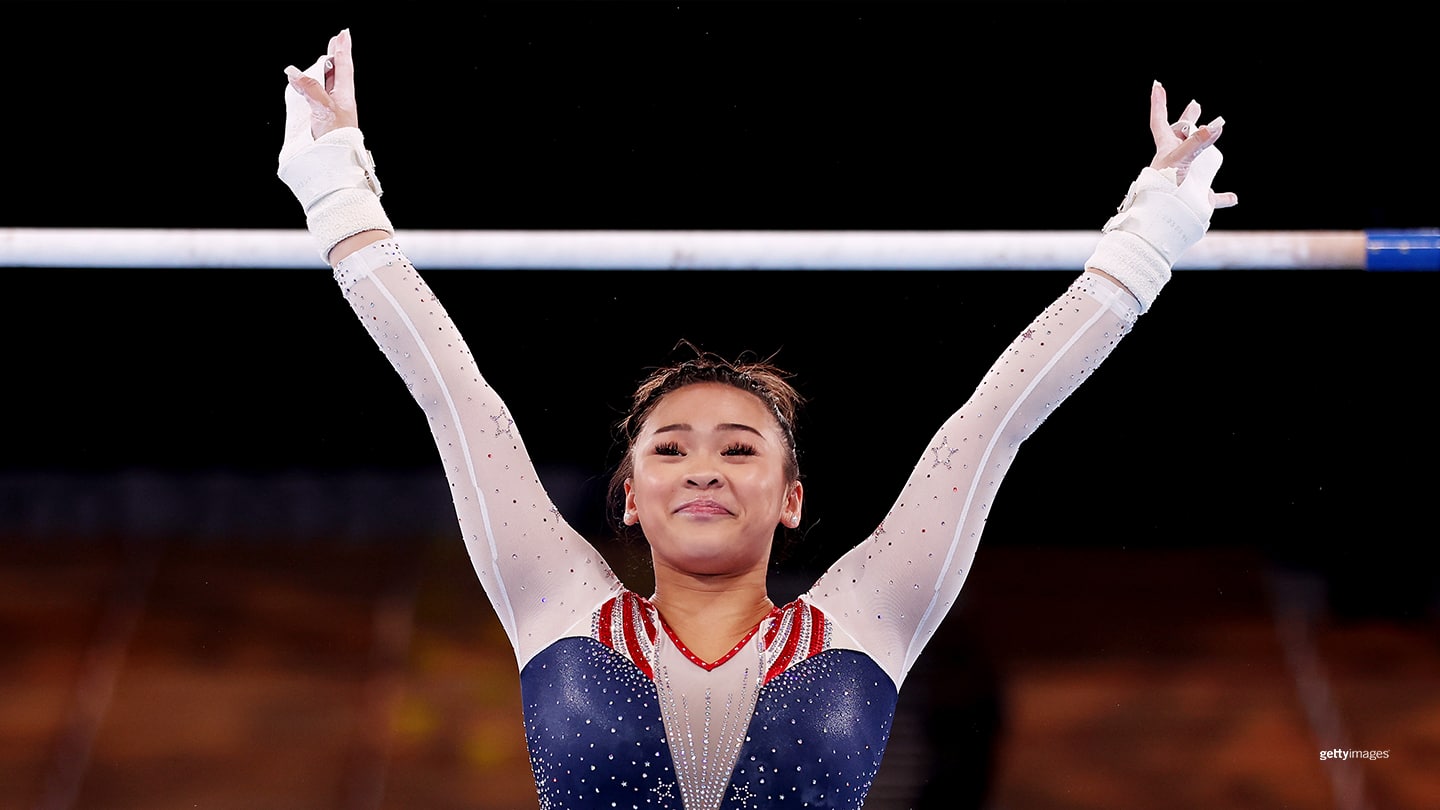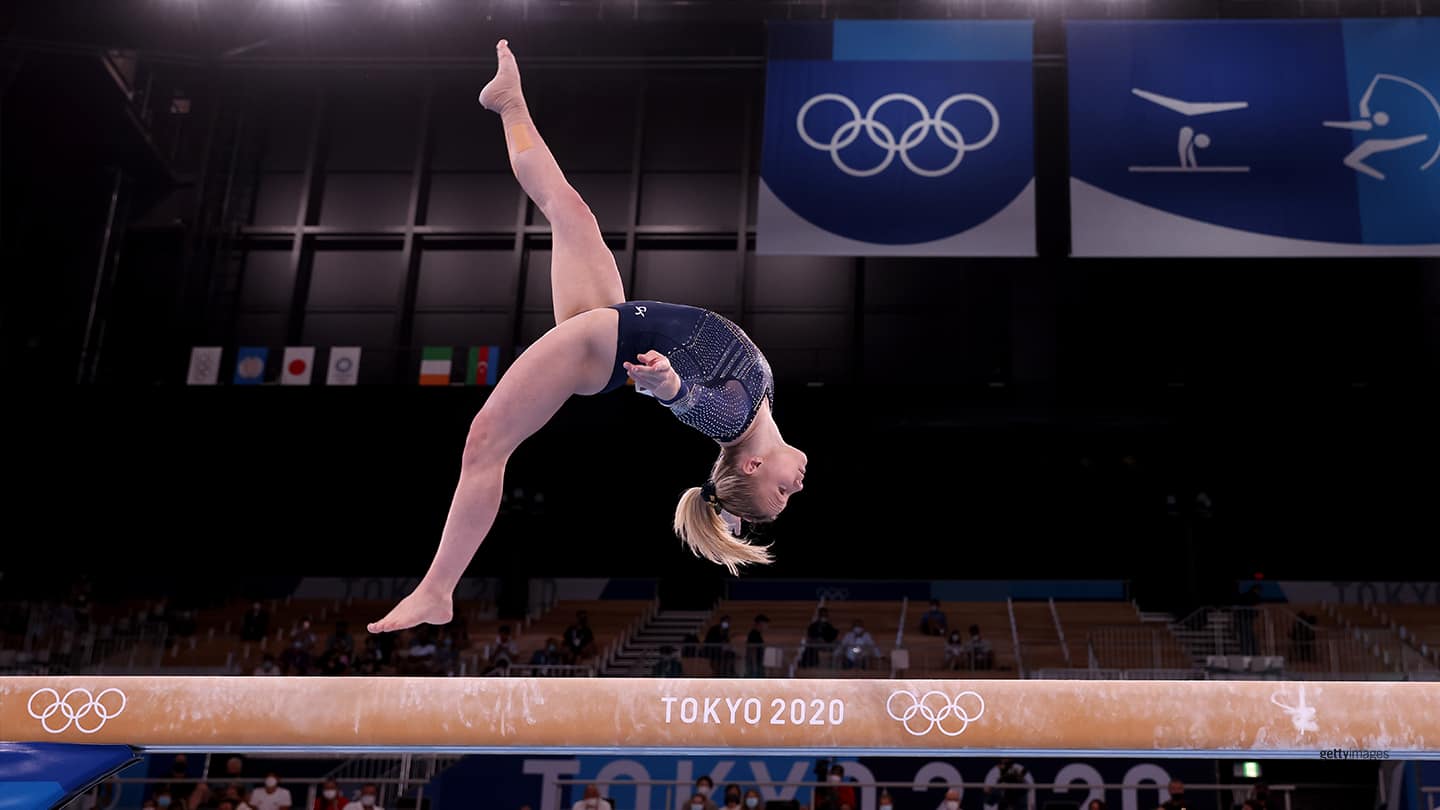
Suni Lee Steps Into The Spotlight, Soars To All-Around Gymnastics Gold
by Chris McDougall

Sunisa Lee competes on uneven bars at the Olympic Games Tokyo 2020 on July 29, 2021 in Tokyo, Japan.
TOKYO — The first Hmong refugees arrived in Minnesota in 1975. Today that population has grown to 80,000 people, its members now represented throughout business, government and culture in the North Star State.
On Thursday, a daughter of that diaspora added a new milestone to the Hmong American story: Olympic champion.
Sunisa Lee, an 18-year-old from St. Paul who goes by Suni, won the women’s gymnastics all-around gold medal, scoring 57.433 to hold off Brazil’s Rebeca Andrade by .135 and the Russian Olympic Committee’s Angelina Melnikova by .234 at Tokyo’s Ariake Gymnastics Centre. Fellow American Jade Carey placed eighth, scoring 54.199.
With her win, Lee, the first Hmong American to make a U.S. Olympic Team, becomes the fifth American woman to win the Olympic all-around title in the past five tries. Combining the Olympics and world championships, a U.S. woman has now won every global all-around title since 2011.
The feeling was “surreal,” Lee said, her shiny new gold medal hanging from her neck. “It’s crazy” she repeated, over and over again.
“Coming into this competition, I didn’t even think that I could be competing for a gold medal,” the recent South St. Paul High School grad said. “I was coming to compete for a silver medal.”
Lee knew she’d be a favorite for the team gold medal, and she’ll have an opportunity next week to win individual medals in the uneven bars and balance beam finals. In the prestigious all-around, though, Lee was not alone in seeing the silver medal as her personal first place.
Simone Biles has that effect on things.
The reigning champ of just about everything, Biles hadn’t lost an all-around competition since 2013, and there was little reason to think that streak would end in Tokyo. Then suddenly it did.
On Tuesday, Biles withdrew following the first rotation in the team competition, citing medical reasons. Continuing on without her, the Americans managed to still pull off a silver medal. Then, on Wednesday, Biles confirmed she’d miss the all-around final as well.
The repercussions for Lee, and the rest of the field, were impossible to ignore.
“I’ve just been telling myself to do nothing less, nothing more,” Lee said. “Because everything that I’ve been doing has been pretty good so far.”
In a suddenly wide-open contest, Lee rose to the top doing just that. With the performance of a lifetime, she hit her four routines with stunning resoluteness, racking up just enough tenths to hold off Andrade, who in her own masterful performance became the first Latin American gymnast to make the podium in an Olympic all-around.
Lee has been positioned to seize such an opportunity for some time now.
In 2019, days after her father, John Lee, became partially paralyzed when falling from a ladder, the 16-year-old Suni made her senior debut at the national championships, where she finished as the runner-up to Biles. She’s been Team USA’s No. 2 ever since.
Later that year, with John watching from a hospital bed in Minneapolis, Suni went on to win a full set of medals at the world championships in Germany — gold with the team, silver on floor exercise, bronze on uneven bars — while also making the all-around final.
After a lost 2020, Lee picked up where she left off this summer, finishing as runner-up to Biles at both the national championships and Olympic trials. Taking advantage of a few Biles errors, Lee actually outscored her teammate on the second night a trials, something nobody had done in eight years.
“I know it probably won’t happen again,” Lee said after.
Then the unthinkable happened.
On Tuesday, Biles began the team competition by under-rotating her vault by a full spin. Something had felt off all day, she said later; the burden of expectations and obligations in Tokyo had been weighing on her, and when she went to warm up for the team competition she discovered her air awareness was out of wack. For a gymnast who performs skills so big they awe even her peers, that’s a pretty big deal.
With Biles on indefinite hiatus, much attention turned to Lee, who had qualified for the all-around finals in third place, .565 points behind Biles.
“Going into this meet I felt like there was a lot of pressure on me because I had been second to her the whole season, basically,” Lee said. “So I knew that people were kind of counting on me to either get second or win the gold medal. I tried not to focus on that because I knew that I would get too nervous.”
Any nerves on Thursday appeared to be of the steel variety.
Rotating in the same order as in the team competition, Lee hit what might have been her best double-twisting Yurchenko vault ever to score 14.600 — a .267-point improvement on her score from qualifying. Then she broke out the harder version of her already world-class bars routine to add a tenth there too, her score of 15.300 tying for the best on the night of any event.
It nearly all came apart on the unforgiving balance beam, though. Lee almost fell on her wolf turn early in the routine, then battled through minor wobbles throughout. Though she avoided any catastrophic mistakes, a score of 13.833 left her with just a .101-point lead going into the final rotation.
Andrade had outscored Lee by more than six tenths on the event during qualifying. It was perfectly conceivable that Melnikova and her ROC teammate Vladislava Urazova could pass Lee, too.
All Lee could do was hit her routine and hope for the best. That’s exactly what she did.

Jade Carey competes on balance beam at the Olympic Games Tokyo 2020 on July 29, 2021 in Tokyo, Japan.
Just as she had done in the team final, when she had to fill Biles’ spot in the lineup despite not having a full warmup, Lee was again electric. Her tumbling was sharp, her landings firm; even though she lowered her difficulty by removing a tumbling pass, Lee made up for it with execution to post a strong score of 13.700.
Then she had to wait.
Andrade, competing directly after Lee, had been on a mission early. The Brazilian had torn her ACL three times in four years, most recently in 2019, but showed no signs of weakness through her first through routines. After scoring 14.066 on floor exercise in qualifying, she now needed just 13.801 to catch Lee.
Then she stepped out of bounds. Twice.
The mostly empty arena, filled only with journalists, volunteers and some other delegation members, buzzed as the judges tabulated her score.
“The waiting game was something that I hated so much,” Lee said.
It was worth it. Andrade scored 13.666, her .400 in deductions proving to be the difference.
“When I saw that my score came out on top it was just like so emotional,” said Lee, who plans to compete at Auburn following her elite career. “I didn’t think I would ever be here. There was one point where I wanted to quit, so to even say that I’m an Olympic gold medals and just be here, it’s so crazy.”
That moment of doubt came a year ago, during the pandemic.
Lee lost two close relatives to COVID-19, then saw her motivation sapped while quarantined in her bedroom, afraid she’d catch the disease herself and spread it to her family. To make matters worse, shortly after resuming training, Lee broke her foot.
Lee eventually rediscovered her drive. The foot problems lingered. As a byproduct of the broken bone, Lee developed Achilles tendinitis in her left ankle.
“It just wasn’t getting better,” Lee said, “and it just felt like I wasn’t ever going to be able to make it to the Olympics.”
The injury kept her from doing all four events when competitions resumed in February 2021. Even when she returned to the all-around in June, at the national championships, Lee was visibly limping between events.
Thanks to some aggressive therapy, it’s rapidly improved since.
“Once I warm it up it’s fine,” she said.
Throughout those difficult months, Lee turned to her family, as well as her community, for moral support.
John Lee is the emotional rock, giving his daughter pep talks before each meet. That was the case again Thursday, though this time it was virtual, with John was thousands of miles away in Minnesota.
“He told me not to focus on the scores or anything like that, because in their hearts I was already a winner,” Lee said.
John was speaking to her from an event center near the family’s home, where dozens of friends and relatives had woken up early to cheer on Suni at a watch party. Though on the other side of the world, the teenager was feeling the love coming from that watch party, and from Minnesota’s Hmong community at large.
The Hmong are an ethnic group from Southeast Asia. During the Vietnam War, they partnered with the CIA for a covert operation, playing a key role in the U.S. effort but suffering significant casualties. After the war, the Hmong found themselves refugees in their own homeland, so many fled. Around 100,000 came to the U.S.; the largest concentration ended up in St. Paul.
That’s where Suni’s parents emigrated, with John arriving in 1979 and her mom, Yeev Thoj, following eight years later, when both were kids.
Since those very first refugees arrived in Minnesota in 1975, the Hmong (pronounced “mong”) have established a tight-knit community that’s now enmeshed into the fabric of the Twin Cities. Although challenges persist, and the poverty rate among Hmong is considerably higher than the general population, such numbers have improved dramatically over time. Meanwhile, Hmong Americans can now be found in prominent roles throughout the state, whether that be in public office, anchoring the evening news or opening acclaimed restaurants.
That’s the future Lee wants to see for her community, and one she’s already a part of.
“I want people to know that you can reach your dreams and you can do what you want to do, because you never know what’s going to happen in the end,” she said. “So never give up on your dreams.”
Want to follow Team USA athletes during the Olympic Games Tokyo 2020? Visit TeamUSA.org/Tokyo2020 to view the medal table, results and competition schedule.
Chrös McDougall #
Chrös McDougall has covered the Olympic and Paralympic Movement for TeamUSA.org since 2009 on behalf of Red Line Editorial, Inc. He is based in Minneapolis-St. Paul.